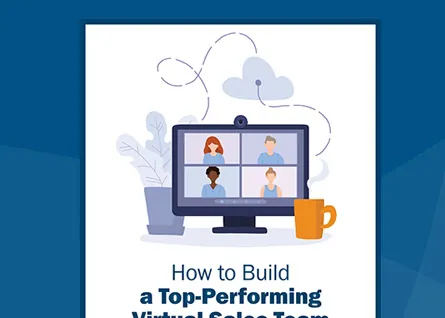Best Practices for Virtual Selling

It’s been almost a year since we last wrote about virtual selling. In that time, companies have returned from COVID restrictions and virtual selling has since been fully entrenched into sales culture. It’s arrived and here to stay. This means it’s time to step up our virtual selling game if we want to outsell the competition. In this article, we’ll explore the latest best practices and the new 2.0 version of virtual selling that you can apply immediately to create a better virtual sales meeting.
Create a Virtual Selling Space
The trigger for this article was brought about by a recent virtual sales call I had with a salesperson. He had what looked like a custom virtual selling studio. The background wall and chair were the color of the brand he was working with. The lighting was perfect, and he had a boom mic that had crystal-clear audio. I was so impressed, I asked how much it cost him to set it up. He replied that his company provided a $750 allowance, which covered the studio.
One of the key aspects of the 2.0 virtual selling studio setup was using an external camera. If you have ever been on a virtual call and the presenter has two screens, the one with the camera being opposite to where the presenter is often looking, you know how distracting that can be. There’s no eye-contact throughout the presentation, and it just comes across as cold.
An external camera can be positioned for the best possible viewing angle. Additionally, they have a wider field of view, which improves the feel of the virtual sales meeting. If you are on video calls all day, investing in a quality external camera will be a wise investment.
Controlling Background Noise
We’ve all been on a call where we hear a dog barking or a child crying in the background. They are usually not deal breakers, but they are definitely not deal helpers either. When clients hear unwanted background noise, it’s a distraction. Distracting background noise comes in a variety of flavors. It could be an electronic hum or static noise from a Bluetooth headset. Standard computer microphones or Bluetooth headphones do not provide a great way to adjust inputs and ambient noise.
That’s why I’m a fan of the boom style mics you see on podcasts. These are typically USB mics, and one of the most popular models is the Blue Yeti. It runs about $85, and if you’ve ever heard the sound quality, you know the value. Plus, it looks cool. Looks aside, poor sound quality for your customers hinders communication. With virtual selling being critical to sales success, investing in a quality microphone is a best practice for virtual selling 2.0.
While investing in a quality microphone is one option, there is another. I’ve been experimenting with Krisp, a software that removes background noise and echoes. A cool feature of this software is that it tracks the talk time of the individual rep. This feature helps sellers ensure they are providing a collaborative presentation. It’s never good to see a 30-minute meeting where the sales rep did 29 minutes of talking. They have a free option that provides 60 minutes of talk time per day. I’ve tested it with music on in the background, and my participants could not hear the music, even when I turned it up. The voice quality is not quite as good as the Yeti, but it definitely removes the background noise and echo.
Integrating Multiple Platforms
One of the biggest headaches for sales reps who sell virtually are the numerous platforms and applications that they rely on. Data collection is a critical sales task, but sales reps can often struggle updating data from one platform to the CRM, especially when sales productivity applications are not integrated well into your current tech stack. This can quickly lead to frustration and corners being cut by sales reps implementing ad-hoc processes that seem more convenient to them. If your CRM and other sales productivity tools are poorly integrated with each other, it will slow your sales reps down. This ultimately leads to inaccurate or incomplete data, which makes forecasting nearly impossible for the sales manager.
Today, there are software solutions available off the shelf to alleviate note taking and manual data upload. Many of these solutions use artificial intelligence to record, transcribe, and analyze virtual meetings. The name for this type of technology is conversational intelligence. The reason conversational intelligence is a must have for virtual sales teams is because it eliminates duplicate data entry and the AI helps figure out specific interests like budget, pricing, and next steps. Not only is it a time saver for the sales reps, but sales leaders can gain visibility into what is working and what is not, without having to go back and watch hours and hours of virtual meetings.
Lighting for Virtual Selling
If you’ve ever been in a virtual meeting and the presenter had a glare coming off their glasses, you know how distracting bad lighting can be. We’ve all been in meetings where the lighting was less than ideal. Upgrading lighting is a best practice for virtual sales teams. Taking the shade off a table lamp will not work for virtual selling 2.0.
Very often, our home office has a window, and depending on the time of the day, the lighting in the room can change. That’s why it is important to have a lighting setup with adjustable brightness. Sometimes, you may want to dim the lights to avoid glare. Other times, you may want to brighten the lighting to avoid shadows. There are a variety of lighting products on the market for under $100, so there is no reason for a sales rep to have bad lighting.
The Cost of Not Investing
Many companies have not upgraded their virtual team selling environment. They are content to use the basic backgrounds and pre-installed hardware. This traditional setup is virtual selling 1.0 if you will. Now we’ve evolved to virtual selling 2.0. The question that must be asked is what it will cost virtual sales teams to not invest in a 2.0 virtual selling setup.
In Conclusion
Virtual selling is here to stay for most sales organizations. Although it is not a new sales model, the technology and best practices of virtual selling are evolving. If you have your sales team conducting virtual meetings from the basic camera and microphone on a laptop without additional technology or software, you are not providing your customers with the best online experience possible. When an organization takes the time and effort to create a virtual selling studio, it commands the buyers’ attention.
I know we are sales professionals, not filmmakers or cinematographers, but traditional virtual selling set ups are no longer enough. If your team has mastered the basics of virtual selling, it’s now time to look for areas of improvement. The fake bookshelves for backdrops are no longer a best practice. Providing your team with the tools and technology so they can confidently present and differentiate themselves from the competition is what virtual selling 2.0 is all about. If your team needs help or is looking to explore training options for virtual selling, schedule a call here.

- Account Planning (11)
- Awards (49)
- Client Testimonial (37)
- Personal Branding (19)
- Podcast (11)
- Research (70)
- Sales Career Development (87)
- Sales Coaching (156)
- Sales Consulting (137)
- Sales Culture (170)
- Sales Enablement (354)
- Sales Leadership (109)
- Sales Management (248)
- Sales Negotiation (16)
- Sales Prospecting (125)
- Sales Role-Playing (18)
- Sales Training (234)
- Selling Strategies (263)
- Soft Skills (70)
- Talent Management (94)
- Trusted Advisor (27)
- Virtual Selling (49)
- Webinar (9)


























